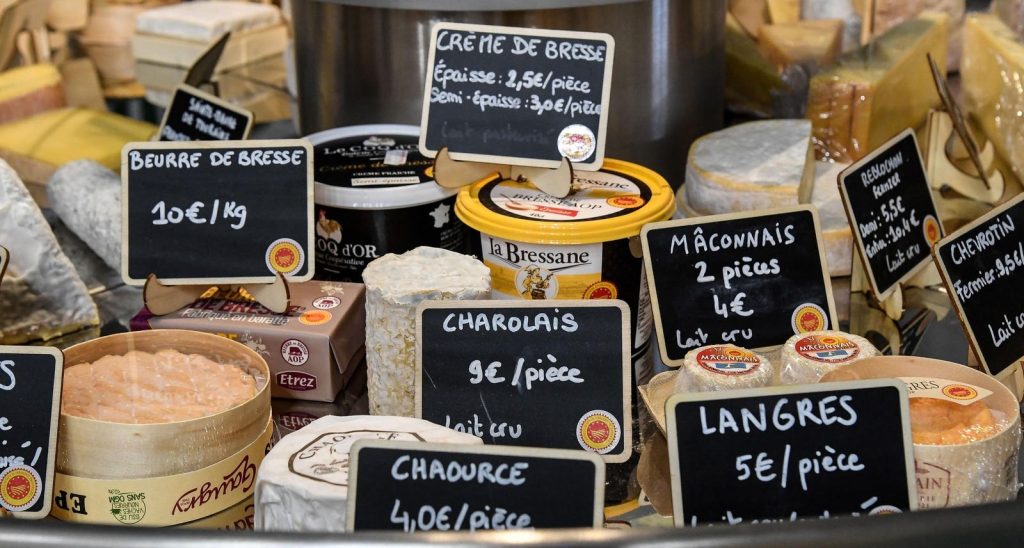Every Friday night, my family celebrates cheese night. Okay, celebrate might be a strong word. But for the last few years, we’ve designated Fridays as cheese nights. At the end of a long week, it’s nice to put out a spread of fruits and vegetables, olives and pickles, bread, and, of course, cheese.
While any cheese will do for cheese night, we have a little cheese snob in us. I come by it honest—on one of my first solo travels, I was lucky enough to watch Caerphilly cheese being made in Wales. It was my first real understanding that there were cheeses beyond American and cheddar (I still love a great cheddar). Years and miles later, we—the kids included—are willing to try all kinds of cheese.
Soft cheeses were the last on our list that we tried. But on a whim, I signed us up for a cheese tasting while visiting France—once we tried different kinds with a bit of guidance, we were hooked. It was particularly interesting to find out how cheeses develop different taste and feel characteristics based on how they are made. And even more interesting? One of the most famous cheeses in France—if not the world—owes its origin to tax.
Making Cheese
First, a quick primer on cheesemaking. The goal of making cheese is to transform milk from a liquid into a solid. This typically happens by adding something—like acid or enzymes—to the milk. As the additives work their magic, the cheese separates into curds and whey (you may recall those from your nursery rhymes). The milk solids or curds are then cut into pieces—for soft cheeses, you cut them into big pieces and move to the next steps. Hard cheeses are cut into bigger pieces and cooked a bit longer to dry them out. At this point, you have cheese— you just have to make it into the shape you like, then salt and age it. Salting adds flavor and acts as a preservative, while aging helps develop flavor.
So what does that have to do with taxes?
Cheese & Taxes
In the 13th, dairy farmers in the Alpine region of Haute-Savoie—about a ten-hour drive south of Paris, not so far from Toulouse—were subject to an annual tax, le droit d’ociège, translated literally as “the right of association.” The tax was collected by feudal lords—largely nobles, but also some clergy—and was calculated based on the number of milk jugs produced in one day by the farmers’ cattle. On tax day, the tax inspectors would come by to observe the milking and take a portion of the butter and cheese produced from the milk as payment.
This left the farmers with a dilemma. They benefitted when their cows produced more milk—except when it came to taxes. To pay less in taxes, the cows would need to appear to produce less milk.
This gave the farmers an idea—what if they altered the timing of their milking on tax day? The farmers opted to not fully milk the cows when the tax inspectors came by, so there was less milk to be tallied. After the inspectors left, the farmers did a second milking. There wasn’t a lot of milk in the second milking, but what was produced was very rich in cream—ideal for making cheese since the goal is to transform the milk into a solid.
The term for a second milking in French is “reblocher,” a verb meaning to pinch the cow’s udder a second time. It was an early form of tax evasion—but resulted in delicious cheese.
About Reblochon
Today, by law, the production of the cheese, called reblochon from reblocher, is restricted to the mountains of Haute-Savoie and the Val d’Arly, in Savoie (sort of like how champagne can only be called champagne if it’s from the Champagne region of France). In 1958, Reblochon was the first cheese in the Savoy region to receive an Appellation d’Origine Contrôlée (AOC) label—now called Protected Designation of Origin (PDO) in the EU.
The cheese is a raw cow’s milk cheese—it does not undergo any heat treatment above 37°C and is not pasteurized. The rind of the cheese is thin and orange-yellow, covered with white foam.
My favorite cheese store describes Reblochon as “a well-proportioned cheese with a nutty aftertaste that contrasts with a strong odour of the cellar. The creamy cheese often has a herbal aroma. From this process, the rind turns a orange-yellow with a velvety texture.”
Alas, you can’t buy Reblochon in the U.S. The FDA banned it in 2004 since it doesn’t meet the required aging time—it’s traditionally aged for just 50 days, which is less than the USDA edict that raw milk cheeses be aged at least 60 days.
The U.S. wasn’t always so averse—they included a whole paragraph on Reblochon in their 1953 Agricultural Handbook.
Read the full article here




